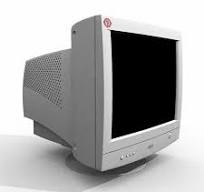What is a CRT Monitor?
The CRT monitor (Cathode Ray Tube monitor) was the primary display technology between 1950 and 2000. CRT stands for Cathode Ray Tube Technology; they utilize high-speed electron beams firing from the back of the tube to excite phosphors on the screen’s inner surface, forming images.
How CRT Monitors Work:
It consists of a vacuum tube where at one end there is an electron gun and in the other, its illuminated screen with phosphor. A beam of electrons from the electron gun is deflected by a magnetic field to sweep the same scanning lines on the screen, from top to bottom. When the electron beam hits the phosphor, it shines and creates an image on the screen. These are actually different phosphors (red, green, and blue).

Advantages and Disadvantages:
Advantages:
- Color Fidelity & Contrast:
CRTs excel in deep color and contrast. They can display excellent black levels and vivid colors, which makes them ideal for color-critical tasks like graphic design. - Reduced Motion Blur:
CRT monitors have high refresh rates, often greater than 85 Hz, reducing motion blur compared to early flat-panel displays.
Disadvantages:
- Bulk & Weight:
CRTs are bulky, heavy, and generally impractical for contemporary use. - Power Usage:
CRTs are less energy-efficient than modern flat-panel technologies like LCD and OLED. - Flicker:
CRTs may flicker at low refresh rates, leading to eye strain after prolonged use.
Phasing Out CRT Technology:
LCD (Liquid Crystal Display) and LED (Light Emitting Diode) technology signaled the end for CRTs. Modern flat-panel monitors are slimmer, lighter, and consume much less power. They also have a clear resolution advantage, which is becoming increasingly critical in today’s high-definition and ultra-high-definition.
However, CRT monitors are still preferred for retro gaming due to their lower input lag and higher frame rates. Additionally, some industries continue to use CRTs for specialized purposes, such as medical imaging equipment or oscilloscopes.
